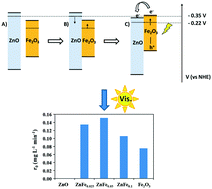Electron transfer in ZnO–Fe2O3 aqueous slurry systems and its effects on visible light photocatalytic activity†
Abstract
ZnFex (x = 0.025, 0.05, and 0.1) nanocomposites and pure ZnO and Fe2O3 photocatalysts were synthesized by a simple sol–gel route and characterized by means of specific surface area (SSA) analysis, X-ray diffraction (XRD), diffuse reflectance spectroscopy (DRS), and transmission electron microscopy/energy dispersive X-ray spectroscopy (TEM/EDS). Their photocatalytic activity was investigated under visible light by using methylene blue (MB) and benzoic acid (BA) as model compounds. Coupling ZnO and Fe2O3 results in higher photocatalytic activity with respect to the pure materials. Photoelectrochemical characterization performed in slurry systems allowed the elucidation of the electronic structure of the nanocomposites under conditions strongly mimicking the photocatalytic reaction medium. Intense electronic interactions between ZnO and Fe2O3 induce a shift of the bandgap absorption to longer wavelengths. Furthermore a shift of the photogenerated electron potential towards less negative values could be evidenced for the first time by means of these measurements. The electronic configuration obtained after coupling the two semiconductors reduces recombination through efficient electron transfer from Fe2O3 to ZnO, thus justifying the observed photoactivity results.



 Please wait while we load your content...
Please wait while we load your content...